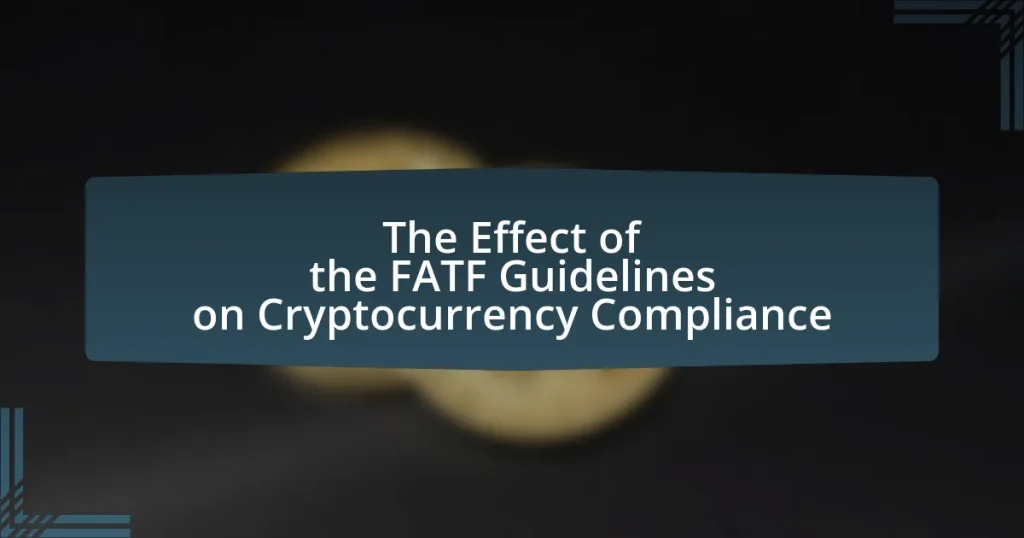The Financial Action Task Force (FATF) Guidelines are critical recommendations aimed at combating money laundering and terrorist financing, particularly in the context of cryptocurrency compliance. These guidelines mandate that countries implement measures such as Know Your Customer (KYC) and Anti-Money Laundering (AML) protocols to enhance transparency and accountability in cryptocurrency transactions. The article explores how these guidelines define cryptocurrency, the key principles that apply, and their global regulatory implications. It also addresses the challenges faced by cryptocurrency businesses in adhering to these guidelines and outlines best practices for compliance, emphasizing the importance of international cooperation and technological advancements in navigating the evolving regulatory landscape.

What are the FATF Guidelines and their relevance to cryptocurrency compliance?
The FATF Guidelines are a set of recommendations established by the Financial Action Task Force to combat money laundering and terrorist financing, which are increasingly relevant to cryptocurrency compliance. These guidelines require countries to implement measures that ensure transparency and accountability in cryptocurrency transactions, including Know Your Customer (KYC) and Anti-Money Laundering (AML) protocols. The FATF’s emphasis on regulating virtual assets and service providers aims to mitigate risks associated with the anonymity and cross-border nature of cryptocurrencies, thereby enhancing global financial security. Compliance with these guidelines is crucial for cryptocurrency exchanges and businesses to avoid legal repercussions and to foster trust within the financial system.
How do the FATF Guidelines define cryptocurrency?
The FATF Guidelines define cryptocurrency as a digital representation of value that can be digitally traded or transferred and can be used for payment or investment purposes. This definition encompasses various forms of cryptocurrencies, including those that are decentralized and those that are issued by central authorities. The FATF emphasizes that cryptocurrencies can be used for illicit activities, which necessitates regulatory measures to ensure compliance with anti-money laundering (AML) and counter-terrorism financing (CTF) standards.
What key principles of the FATF Guidelines apply to cryptocurrencies?
The key principles of the FATF Guidelines that apply to cryptocurrencies include risk-based approaches, customer due diligence (CDD), and reporting obligations. The FATF emphasizes that countries should assess and mitigate risks associated with virtual assets, ensuring that cryptocurrency service providers implement CDD measures to verify the identity of their customers. Additionally, these providers are required to report suspicious transactions to relevant authorities, aligning with the FATF’s broader goals of combating money laundering and terrorist financing. These principles are crucial for enhancing the integrity of the cryptocurrency ecosystem and ensuring compliance with international standards.
How do these definitions impact regulatory frameworks globally?
The definitions established by the FATF guidelines significantly influence regulatory frameworks globally by providing a standardized approach to cryptocurrency compliance. These definitions help countries align their regulations with international norms, facilitating cooperation and consistency in combating money laundering and terrorist financing. For instance, the FATF’s classification of virtual assets and virtual asset service providers necessitates that jurisdictions implement specific regulatory measures, such as customer due diligence and reporting obligations. This alignment is evidenced by the adoption of similar regulatory frameworks in various countries, including the European Union’s 5th Anti-Money Laundering Directive, which reflects FATF’s recommendations. Consequently, these definitions not only shape national laws but also enhance global regulatory coherence in the cryptocurrency sector.
Why were the FATF Guidelines established?
The FATF Guidelines were established to combat money laundering and terrorist financing on a global scale. The Financial Action Task Force (FATF), formed in 1989, aimed to create a standardized framework for countries to implement effective measures against these financial crimes. The guidelines provide recommendations that help nations develop robust legal and regulatory frameworks, ensuring that financial systems are not exploited for illicit activities. This initiative is supported by the fact that the FATF has identified money laundering and terrorist financing as significant threats to the integrity of financial systems worldwide, necessitating a coordinated international response.
What issues in the financial system prompted the creation of these guidelines?
The issues in the financial system that prompted the creation of the FATF guidelines include the rise of money laundering, terrorist financing, and the increasing use of cryptocurrencies for illicit activities. These concerns were highlighted by the Financial Action Task Force (FATF) as they observed that traditional regulatory frameworks were inadequate to address the unique challenges posed by digital assets. The FATF aimed to enhance global standards for combating these threats, ensuring that countries implement measures to prevent the misuse of cryptocurrencies in financial crimes.
How do the FATF Guidelines aim to combat money laundering and terrorist financing?
The FATF Guidelines aim to combat money laundering and terrorist financing by establishing a comprehensive framework for countries to implement effective measures. These guidelines promote risk-based approaches, requiring jurisdictions to assess and mitigate risks associated with money laundering and terrorist financing. They also emphasize the importance of customer due diligence, reporting suspicious transactions, and enhancing international cooperation among financial institutions and law enforcement agencies. By setting standards and encouraging compliance, the FATF Guidelines facilitate the identification and disruption of illicit financial flows, thereby strengthening the global financial system against abuse.

How do the FATF Guidelines influence cryptocurrency exchanges and service providers?
The FATF Guidelines significantly influence cryptocurrency exchanges and service providers by establishing a framework for anti-money laundering (AML) and combating the financing of terrorism (CFT) measures. These guidelines require exchanges and service providers to implement Know Your Customer (KYC) protocols, conduct risk assessments, and report suspicious activities to relevant authorities. Compliance with these guidelines is essential for exchanges to operate legally in many jurisdictions, as failure to adhere can result in penalties, loss of licenses, or being barred from operating in certain markets. For instance, the FATF’s Recommendation 15 specifically addresses virtual assets and service providers, mandating that they be subject to the same AML/CFT obligations as traditional financial institutions. This regulatory pressure has led many exchanges to enhance their compliance programs and adopt more stringent customer verification processes.
What compliance requirements do cryptocurrency exchanges face under the FATF Guidelines?
Cryptocurrency exchanges must adhere to several compliance requirements under the FATF Guidelines, primarily focusing on customer due diligence (CDD), record-keeping, and reporting suspicious activities. These guidelines mandate that exchanges implement robust CDD measures to verify the identity of their customers, including collecting and verifying personal information. Additionally, exchanges are required to maintain transaction records for a minimum of five years and report any suspicious transactions to relevant authorities. The FATF emphasizes the importance of risk-based approaches, urging exchanges to assess and mitigate risks associated with money laundering and terrorist financing.
How do these requirements affect the operations of cryptocurrency exchanges?
The requirements set by the FATF guidelines significantly impact the operations of cryptocurrency exchanges by mandating enhanced compliance measures. These guidelines necessitate that exchanges implement robust Know Your Customer (KYC) protocols, which require the collection and verification of user identities. As a result, exchanges must invest in technology and processes to ensure compliance, which can increase operational costs and complexity. Furthermore, the guidelines impose obligations for transaction monitoring and reporting suspicious activities, compelling exchanges to adopt advanced surveillance systems. This shift not only affects the operational workflow but also influences the user experience, as customers may face longer verification times and increased scrutiny. Compliance with these requirements is essential for exchanges to avoid penalties and maintain their licenses, thereby shaping their overall business strategies and operational frameworks.
What are the implications for customer verification processes?
The implications for customer verification processes under the FATF guidelines include enhanced due diligence requirements and stricter identity verification protocols. These guidelines mandate that cryptocurrency businesses implement robust Know Your Customer (KYC) measures to prevent money laundering and terrorist financing. For instance, the FATF emphasizes the need for businesses to collect and verify customer information, such as names, addresses, and identification documents, which increases operational costs and complexity. Additionally, non-compliance can lead to significant penalties and reputational damage, as evidenced by cases where firms faced regulatory actions for inadequate verification processes.
How do different countries implement the FATF Guidelines for cryptocurrency compliance?
Different countries implement the FATF Guidelines for cryptocurrency compliance through various regulatory frameworks tailored to their specific legal and economic contexts. For instance, the United States enforces these guidelines by requiring cryptocurrency exchanges to register as money services businesses and comply with anti-money laundering (AML) regulations, as outlined by the Financial Crimes Enforcement Network (FinCEN). In contrast, the European Union has adopted the Fifth Anti-Money Laundering Directive, which mandates that cryptocurrency service providers conduct customer due diligence and report suspicious activities.
Countries like Japan have established a licensing system for cryptocurrency exchanges, ensuring they adhere to strict AML and counter-terrorism financing (CTF) measures, while countries such as Singapore have integrated FATF recommendations into their Payment Services Act, which regulates digital payment token services. These implementations reflect a global trend towards enhancing regulatory oversight in the cryptocurrency sector, aiming to mitigate risks associated with money laundering and terrorist financing.
What variations exist in the adoption of these guidelines across jurisdictions?
Variations in the adoption of FATF guidelines across jurisdictions include differences in regulatory frameworks, enforcement mechanisms, and compliance timelines. For instance, countries like the United States and the European Union have implemented comprehensive regulations that align closely with FATF recommendations, while others, such as certain Caribbean nations, have adopted more lenient approaches or delayed implementation. The FATF’s mutual evaluation reports highlight these discrepancies, indicating that jurisdictions vary significantly in their commitment to enforcing anti-money laundering (AML) and counter-terrorism financing (CTF) measures related to cryptocurrency.
How do local regulations align or conflict with FATF recommendations?
Local regulations often align with FATF recommendations by incorporating anti-money laundering (AML) and counter-terrorism financing (CTF) measures into their legal frameworks. For instance, many jurisdictions have adopted Know Your Customer (KYC) requirements for cryptocurrency exchanges, mirroring FATF’s guidance on customer due diligence. However, conflicts arise when local regulations are less stringent than FATF standards, such as when certain countries do not mandate comprehensive reporting of suspicious transactions or fail to regulate virtual asset service providers adequately. This discrepancy can lead to gaps in compliance and enforcement, undermining the effectiveness of global efforts to combat financial crime.

What challenges do cryptocurrency businesses face in adhering to the FATF Guidelines?
Cryptocurrency businesses face significant challenges in adhering to the FATF Guidelines, primarily due to the decentralized nature of cryptocurrencies and the lack of uniform regulatory frameworks across jurisdictions. The decentralized structure complicates the identification of users and transactions, making it difficult for businesses to implement effective Know Your Customer (KYC) and Anti-Money Laundering (AML) measures as mandated by the FATF. Additionally, the rapid evolution of technology in the cryptocurrency space often outpaces regulatory developments, leading to uncertainty and compliance difficulties. According to a 2021 report by the FATF, only 37% of countries had implemented effective measures to regulate virtual assets, highlighting the inconsistency in global compliance efforts. This inconsistency creates an environment where cryptocurrency businesses struggle to meet varying regulatory expectations, further complicating their adherence to FATF Guidelines.
What are the common compliance challenges for cryptocurrency businesses?
Common compliance challenges for cryptocurrency businesses include navigating complex regulatory frameworks, ensuring anti-money laundering (AML) and know your customer (KYC) compliance, and managing the risk of regulatory changes. Cryptocurrency businesses often face difficulties in interpreting and adhering to varying regulations across jurisdictions, which can lead to inconsistent compliance practices. Additionally, the implementation of effective AML and KYC measures is crucial, as failure to do so can result in significant penalties; for instance, in 2020, a major cryptocurrency exchange was fined $1.1 million for inadequate KYC processes. Lastly, the rapidly evolving nature of cryptocurrency regulations means that businesses must continuously adapt to new guidelines, such as those set forth by the Financial Action Task Force (FATF), which can create uncertainty and operational challenges.
How do technological limitations impact compliance efforts?
Technological limitations significantly hinder compliance efforts by restricting the ability to effectively monitor and analyze transactions. For instance, inadequate data processing capabilities can lead to delays in identifying suspicious activities, which is critical for adhering to the Financial Action Task Force (FATF) guidelines. Additionally, the lack of interoperability between different blockchain systems complicates the tracking of cryptocurrency flows, making it challenging for compliance teams to gather comprehensive data necessary for reporting and risk assessment. These limitations can result in non-compliance, exposing organizations to regulatory penalties and reputational damage.
What role does the lack of clear regulations play in these challenges?
The lack of clear regulations significantly exacerbates challenges in cryptocurrency compliance. Without definitive guidelines, businesses and financial institutions face uncertainty regarding their obligations, leading to inconsistent practices and potential non-compliance with the Financial Action Task Force (FATF) recommendations. This ambiguity can result in increased risks of money laundering and terrorist financing, as entities may not implement adequate measures to mitigate these threats. For instance, a 2021 report by the FATF highlighted that jurisdictions with vague regulatory frameworks often experience higher incidences of illicit activities in the cryptocurrency space, underscoring the critical need for clear regulations to enhance compliance and security.
How can cryptocurrency businesses effectively navigate FATF compliance?
Cryptocurrency businesses can effectively navigate FATF compliance by implementing robust Anti-Money Laundering (AML) and Counter-Terrorism Financing (CTF) measures. These measures include conducting thorough customer due diligence (CDD), maintaining accurate records, and reporting suspicious activities to relevant authorities.
To ensure compliance, businesses should adopt a risk-based approach, assessing the risks associated with their operations and tailoring their compliance programs accordingly. This involves regular training for staff on compliance requirements and the use of technology to monitor transactions for unusual patterns.
Evidence of the importance of these practices is reflected in the FATF’s 2021 report, which emphasizes that jurisdictions should ensure that virtual asset service providers (VASPs) are subject to AML/CFT obligations similar to those applicable to traditional financial institutions. By aligning their operations with these guidelines, cryptocurrency businesses can mitigate risks and enhance their compliance posture.
What best practices should be adopted for compliance with FATF Guidelines?
To comply with FATF Guidelines, entities should adopt best practices such as implementing robust customer due diligence (CDD) measures, conducting regular risk assessments, and maintaining comprehensive transaction records. These practices ensure that organizations can identify and verify the identities of their customers, assess the risks associated with their activities, and keep detailed records to facilitate audits and investigations. According to the FATF’s 2021 report, effective CDD and risk assessment are critical for preventing money laundering and terrorist financing, which are central concerns of the FATF.
How can businesses leverage technology to enhance compliance efforts?
Businesses can leverage technology to enhance compliance efforts by implementing automated compliance management systems that streamline regulatory processes and ensure adherence to guidelines. These systems utilize artificial intelligence and machine learning to analyze vast amounts of data, identify potential compliance risks, and generate real-time reports. For instance, a study by Deloitte found that organizations using automated compliance solutions reduced compliance costs by up to 30% and improved accuracy in reporting. Additionally, blockchain technology can provide transparent and immutable records of transactions, which is particularly beneficial in the cryptocurrency sector, aligning with the FATF guidelines that emphasize traceability and accountability in financial transactions.
What future trends can be anticipated regarding FATF Guidelines and cryptocurrency compliance?
Future trends regarding FATF Guidelines and cryptocurrency compliance indicate a move towards stricter regulatory frameworks and enhanced global cooperation. As governments and regulatory bodies increasingly recognize the risks associated with cryptocurrency, they are likely to adopt more comprehensive measures to ensure compliance with FATF standards. This includes the implementation of travel rules for virtual asset service providers (VASPs) and the requirement for enhanced due diligence on high-risk transactions.
Evidence of this trend can be seen in the FATF’s 2021 report, which emphasized the need for jurisdictions to implement effective measures against money laundering and terrorist financing in the crypto space. Additionally, countries like the United States and members of the European Union are actively working on legislation that aligns with FATF recommendations, signaling a global shift towards more rigorous oversight of cryptocurrency activities.
How might evolving regulations shape the cryptocurrency landscape?
Evolving regulations will significantly shape the cryptocurrency landscape by establishing compliance frameworks that enhance transparency and reduce illicit activities. As regulatory bodies like the Financial Action Task Force (FATF) implement guidelines, cryptocurrencies will likely face stricter Know Your Customer (KYC) and Anti-Money Laundering (AML) requirements. For instance, the FATF’s 2019 guidance emphasizes that virtual asset service providers must identify and verify customers, which can lead to increased legitimacy and trust in the market. This shift may also drive innovation in compliance technologies, as firms adapt to meet regulatory demands while maintaining user privacy. Ultimately, these evolving regulations will influence market dynamics, investor confidence, and the overall adoption of cryptocurrencies.
What role will international cooperation play in future compliance efforts?
International cooperation will be crucial in future compliance efforts, particularly in the context of cryptocurrency regulations. As cryptocurrencies operate across borders, effective compliance requires harmonized regulations and collaborative enforcement among nations. The Financial Action Task Force (FATF) has emphasized that countries must work together to implement its guidelines, which include measures for anti-money laundering and combating the financing of terrorism. For instance, the FATF’s 2021 report highlighted that jurisdictions that share information and best practices are more successful in mitigating risks associated with cryptocurrency transactions. This collaborative approach not only enhances regulatory effectiveness but also fosters trust among nations, enabling a more robust global framework for compliance.
What practical steps can cryptocurrency businesses take to ensure compliance with FATF Guidelines?
Cryptocurrency businesses can ensure compliance with FATF Guidelines by implementing robust customer due diligence (CDD) processes. These processes should include verifying the identity of customers, understanding the nature of their activities, and assessing the risks associated with them. Additionally, businesses must maintain comprehensive records of transactions and report suspicious activities to relevant authorities.
To further enhance compliance, cryptocurrency businesses should adopt a risk-based approach, tailoring their policies and procedures to the specific risks they face. This includes conducting regular training for employees on compliance obligations and the importance of adhering to FATF Guidelines.
Moreover, integrating advanced technology solutions, such as blockchain analytics tools, can help in monitoring transactions for potential money laundering or terrorist financing activities. By following these practical steps, cryptocurrency businesses can align their operations with FATF expectations and mitigate compliance risks effectively.










